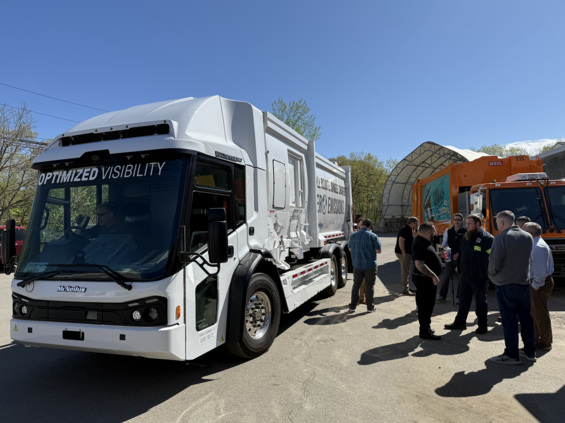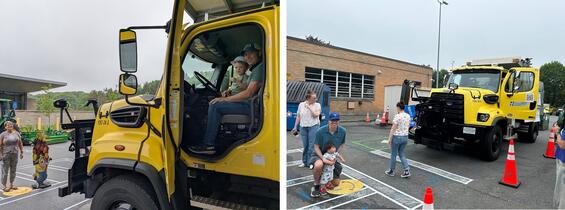What we're doing / the experiment
The Massachusetts legislature is asking us to measure MassDOT's vehicles for their direct vision performance. Additionally, we need to measure our contractor’s vehicles for their direct vision performance.
What is Direct Vision?
Direct vision is the ability of a driver to see firsthand outside their vehicle without the aid of an indirect vision device, such as mirrors or camera displays. Direct vision enables eye contact between a driver and a vulnerable road user (VRU) near the vehicle; indirect vision generally does not.
Blind zones around a vehicle can be made visible through indirect vision, however drivers’ perception and reaction time is significantly faster through direct vision. According to published research, when drivers have direct vision of a pedestrian, they can react in 0.7 seconds, or 50% faster, than when they can see the same pedestrian through indirect vision.

The inside of the cab of a truck. There is a large green area on the windshield and side window that indicates the driver’s Direct vision. There are smaller purple areas on the mirrors and backup camera display that indicate the driver’s Indirect vision. All areas of the interior of the cab that block the driver’s visibility are displayed in orange and indicate the driver’s Blind zone.
To fulfill the requirements of the law, we are partnered with the John A. Volpe National Transportation Systems Center (an entity of the U.S. Department of Transportation) to measure how much direct vision is available to drivers in the various vehicles that make up the MassDOT fleet. We are also developed a process to partner with some of our contractors to measure their vehicles.
Though the law does not require it, we partnered with 10 municipalities to include some of their fleet vehicles in our study so that both the measurement process and the results can be more widely shared and understood. We identified cities and towns that have had serious injury or a fatal crash in the last 10 years in which a large truck was involved. Within that list, we have prioritized among towns who have the same number of truck-involved crashes by using our top 5% at-risk communities with respect to vulnerable road users. We will give each municipality that participates insight into the study and a way to compare fleet vehicles for Direct Vision. That analysis is forthcoming in fall 2024. We will also provide educational materials and strategies for sharing with their constituencies about Direct vision and why it is important.
Why we're doing it
MassDOT has adopted a Safe System approach to roadway safety. This means we are interested in all the various components that contribute to — or detract from — roadway safety. One of those components is Safe Vehicles. As stated in our 2023 Strategic Highway Safety Plan, we intend to take an active role to affect change in vehicle design, features, and use. Safe vehicles are a core component of a Safe System Approach, as vehicle sizes and designs affect the occurrence and severity of collisions.
While vehicle design is usually thought of as a federal responsibility, we believe we have a role to play at the state level to improve the safety of vehicles that travel on state highways and roads in our cities and towns. This study on direct vision will help us better understand which vehicles we should purchase in the future to achieve better safety outcomes. We will share that knowledge with cities and towns.
Finally, as fleet managers across the Commonwealth take on the important work of electrifying their fleets, there is an opportunity to simultaneously incorporate best practice and evidence-based research about Direct Vision standards into those purchasing plans. We are in the right place here in Massachusetts, and at the right time to make meaningful investments in our vehicle fleets that will contribute to improved safety on our roads.
To our knowledge, we are the first State DOT in the U.S. to undertake a Direct Vision fleet measurement study and conducting the largest study of its kind in the nation. We look forward to continuing to be a leader by sharing what we learn with other states and pursuing recommendations in the report that result in safer roadways.
The inside of the cab of a truck during the study. It shows a hand holding a laser measurement tool, a camera rig positioned in the driver seat, and a study team-member holding a laser target outside the passenger side window of the truck.
What we hoped to learn
When we began the study, we set out to learn these four things:
- What is the range of Direct Vision performance in the MassDOT fleet, vehicles of our contractors, and vehicles of partnering municipalities? This will provide a meaningful baseline from which to build a strategy for improving the overall visibility of the fleet, as well as potentially set a course for future policy.
- Which countermeasures are most appropriate for various results of Direct Vision performance of each vehicle? While we ultimately hope to arrive at a minimum level of Direct Vision for vehicle purchases moving forward, we know we will also need to address the current vehicles in the fleet with various modifications or retrofits to increase Direct Vision in the short-term.
- How do people engage with the concept of Direct Vision? The phrase “blind spot” is somewhat commonly used, but terms like Direct Vision, Indirect Vision, and even Blind Zone can be less familiar. Through simple but effective graphics and visual demonstrations, we hope to raise awareness of vehicle design changes that have been taking place for decades and what potential impacts those design changes have on the safety of people outside of the vehicles themselves.
- What other questions should we be asking? As with any good research project, we hope to come out of it with additional questions worthy of follow-up consideration. We also hope to identify new partners through the research process who can help us build a coalition to continue the conversation and implementation of safety countermeasures.
What we learned in the study
The Commonwealth of Massachusetts Direct Vision Report take the 60 vehicles measured in the study and compares different years, makes, and models against one another in a given vehicle classification (light-duty, medium-duty, heavy-duty). The report covers the methodlogy used to measure vehicles, detailed graphics of the results, an explanation of countermeasures that can be undertaken, and a series of potential paths forward for action and additional research.
While not comprehensive, here are three of the findings from the report
- Downsize the vehicle whenever possible: On average, light-duty vehicles have the highest visibility in fleets we studied. Medium-duty vehicles have lower visibility, and heavy-duty vehicles have the lowest visibility. Picking the smallest vehicle possible affords better visibility.
- Drivers in heavy-duty vehicles cannot easily see people on the street:
- 50% of the heavy-duty vehicles in the study cannot see a child directly in front of the vehicle in the crosswalk.
- Side visibility is even worse. For the heavy-duty vehicles studied, drivers in 90% of the trucks cannot see a child in the bike lane and 80% cannot see an adult in a bike lane.
- Driver visibility is mostly getting worse, but there is hope: Visibility in weight class 3 and 4 vehicles appears to be decreasing in newer generations of legacy models. In contrast, new medium-duty entrants, such as the REE P7C, appear to be designed for enhanced direct vision, and these vehicles demonstrate higher visibility, particularly forward of the driver. Of the heavy-duty vehicles measured, the cab-forward style tended to have higher forward visibility. Some of these vehicles had more passenger-side visibility, but this was not always the case.
Taking things further
With the completion of the Direct Vision study, we focused on bringing our learnings to two audiences: fleet owners and operators; and families with young children.
Try and Drive
Based on a similar exercise in our Empathy at the Intersection event, we organized a ‘Try and Drive’ event at the Waltham Public Works Department garage in April 2025. Representatives from nine municipalities attended and explored the visibility from two high-vision truck cabs. Additionally, we also had two kei trucks on site. Since one of the findings of the report was that downsizing a vehicle generally improves visibility, we wanted to show one example of vehicle downsizing.
Participants shared their feedback, including insights such as:
- Better visibility would help me plan more easily, specifically tight turns in Winter.
- Definitely a smooth[er] drive for a truck that size.
- I'd throw a service body on [a kei truck] and call it a day.
We also heard about challenges regarding fleet turnover, including:
- Electrification is hard! I can't get charging stations in my DPW yard because of the placement of the grid. You can't expect me to relocate the DPW.
- I like cabover trucks but there just isn't the option for Class 8 dump bodies on cabovers at the moment.

Truck’s eye view
We wanted to bring the results of the Direct Vision Study to families with young children so they could also be aware of the findings. We thought MassDOT’s District Touch-a-Truck events would be a great place to set up one portion of an intersection and explain the results. We modeled our event based on large truck education sessions held in New York City. In June 2025, we hosted five simultaneous Truck’s Eye View events at MassDOT District Offices.
Replicating standard-dimension stop bars, crosswalks, and bike lanes per the Manual on Uniform Traffic Control Devices, we set up a portion of an intersection near a heavy-duty vehicle at the Touch-a-Truck events. The goal was to have a family member sit in the cab of the truck and determine whether they could see their child in the crosswalk or in the bike lane. We had posters with findings from the study taped up near the vehicle and a QR code with a link to learn more about the study.

Who's involved
- MassDOT
- U.S. Department of Transportation Volpe Center
- City of Boston
- City of Everett
- City of Gardner
- City of Lynn
- City of Medford
- City of Needham
- City of Somerville
- City of Waltham
- City of Westfield